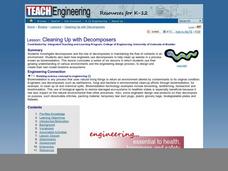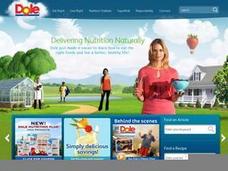Curated OER
What's the Price?
Fourth graders learn about price and comparative shopping. In this price and comparative shopping lesson, 4th graders read Amy Axelrod's, Pigs Go To Market: Fun with Math and Shopping. They use the book to investigate the meaning of...
Curated OER
Not Everything is More Expensive
Students compare prices and determine percent increases and decreases of items in order to make wise purchases. In this percent increases and decreases lesson plan, students calculate the amounts based on grocery store ads.
Curated OER
Party Time
Students engage in a lesson about finding information from the grocery store to put into data that can be measured. The data is found in advertisements and food labels. They plan the cost of a party when using the unit cost of various...
Curated OER
Computer Tracks Lunch Choices
Students read a story called Computer Program Tracks Lunch Choices and answer vocabulary and comprehension questions about it. In this current events literacy lesson plan, students respond to literature by answering questions, recalling...
Curated OER
Money Management-Grocery Shopping for a Family Profile
Learners investigate a family profile and design a menu plan. In this consumer science lesson, students plan and prepare a weekly menu based on a family profile.
Curated OER
Math: Party Time!
Twelfth graders discover how to calculate the total costs for a party. They determine the unit prices of food and supplies, the quantities needed, and complete a chart displaying their findings. Students calculate the costs per serving...
Curated OER
Math-Money
Students complete money matching worksheet. They work with an aid or peer tutor with coin tray, name each coin shown (use native language or alternative speech method). Alternative assessment methods are used.
Curated OER
Grand Grocery Graphs
Students experience creating their own graphs on graph paper and the computer program "Graph Club." They approach this task by utilizing food as their primary source for the activities. In addition, they interact with their peers as they...
Curated OER
Moving Out
Learners determine their cost of living. In this determining their cost of living instructional activity, students think of ten necessary things they would need if they moved out of their parents house. Learners research the...
Curated OER
"how To Think Like an Archaeologist" Suggested Pre-visit Activity for Historic Jamestowne
Young scholars study grocery receipts to simulate the archaeological activity of classifying items. They discuss the receipts as if they were find lists.
Curated OER
Wants and Needs
Here is an outstanding lesson on wants versus needs designed for 1st graders. Pupils listen to the book, Something Good which presents themes on wants, needs, choice, resources, and counting money. Pupils complete worksheets embedded in...
Curated OER
Coupon Clippers: Understanding Comparative Shopping
Third graders participate in a shopping spree after listening to Pigs Go to Market: Fun with Math and Shopping. After the story is read aloud, 3rd graders answer discussion questions and review key vocabulary. Students complete provided...
Curated OER
Adding and Multiplying Decimals
Students review the process needed to add and multiply decimals. They work in pairs and use grocery store sale papers to plan a meal for 20 people. They multiply the price of the items to calculate a total cost.
Curated OER
Stretching Your Money with Coupons
Students examine ways to extend their budget with coupons. For this budgeting lesson, students read information about using coupons at the given website. Students make a list of 30-50 products they use in their homes and use online...
Curated OER
The Big Buck Adventure: Part 2
Students go on a pretend shopping spree. In this money instructional activity, students complete a Shopping Spree activity sheet where they pretend they have won $100 and can spend it on a fake shopping spree. Students use...
Curated OER
Not Everything is More Expensive
Students explore percent increases and decreases. They calculate the percent increase and decrease. Students use math to solve problems and communicate. They apply the given formula for percent increase/decrease.
Curated OER
Pancake Pictures
Students explore kitchen math and following multi-step directions by making pancakes. They assemble the ingredients and make the batter. Students create faces, geometric figures, shapes or lines using pancake batter.
Curated OER
Introduce Vocabulary: George's Store at the Shore (Bassede)
Combine counting and vocabulary using Francine Bassede's book George's Store at the Shore, which has learners exploring new words and numbers 1-10. Suggested words for this text are: arrange, assortment, customers,...
Growing Minds
Apple Exploration
Turn your classroom into a farmers' market! Reading Applesauce Season by Eden Ross Lipson or Monica Wellington’s Apple Farmer Annie, launches this investigation of apples, farmers' markets, and the people selling products. The class...
Curated OER
Shots, Standings, and Shopping
Rates and ratios can easily be applied to real-world situations. Learners explore a series of websites in order to procure comparable data. They define ratios and rates, view videos, and use the internet to explore how ratios and rates...
Curated OER
Cleaning Up With Decomposers
Pupils read and discuss decomposers and how they affect the environment. In this decomposers lesson plan, students also discuss how engineers use decomposers to help the environment.
Curated OER
How Far Did It Travel?
Sixth graders read and discuss background and vocabulary. They use the background to develop a flow chart showing the movement of food from farm to table and work independently or in groups to complete an activity. They then use Internet...
Curated OER
Cost Comparison
Students take a tour of a produce department in a grocery store. They explore the concepts of money and a budget. They complete problem solving activities and taste different fruits and vegetables.
Curated OER
Money Matters
Students explore the concept of money. In this money lesson, students role play an economy. Students are divided into three categories- the money factory, construction workers, and the grocery store. Students work cooperatively to make...























